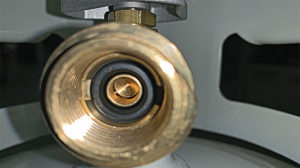Educating personnel, the public about face seal inspection
At the time of this writing, I am off to the National Propane Gas Association’s Technology, Standards & Safety Committee (TS&S) spring meeting in San Antonio. The event provides an opportunity for the industry to consider and recommend proper standards for the storage, transportation and use of propane, including pertinent equipment and appliances.

This is a 20-pound cylinder with an OPD valve and face seal that is in good condition. Photo courtesy of Propane Education & Research Council
This group also considers and recommends proper propane specifications and liaises with technical societies in related fields. TS&S worked with the National Fire Protection Association (NFPA) 58 Technical Committee on container inspection, specifically the section of NFPA 58 regarding face seal inspection on cylinders equipped with certain types of valves.
Since it is the time of year when everyone is excited to get outside and enjoy the change of weather, propane will be there to provide clean energy for recreational vehicles, barbecue grills and a host of other outdoor appliances. People will purchase cylinders through a variety of means – the exchange cabinet, filling dispenser or at a retail propane marketer.
The propane personnel filling those cylinders will need to be educated on a code change in the 2020 edition of NFPA 58 section 7.2.2.7. Prior to filling cylinders with the Compressed Gas Association (CGA) connection type, the face seal shall be carefully examined for defects. The cylinder shall not be filled if the qualified filling technician identifies a defect.
The annex material (A7.2.2.7) goes on to tell us that these types of connections are primarily used on consumer LP gas equipment and are designed to seal both sides of the connection before gas flow occurs. Damage to the seal could result in a leak.
The connections are manufactured in such a way that you cannot replace the seal, and their design may be different depending on the manufacturer. Therefore, if a seal has a defect, the cylinder should not be filled. You can view the actual code at NFPA.org/58.
The Propane Education & Research Council (PERC) published “The PERC Update” in October 2019, which notified the industry about this NFPA code change. It also included a downloadable one-sheet inspection guide to help identify cylinder valve defects and to understand the code requirements. If you would like a copy of the update or inspection guide, or if you have questions about their contents, visit PERC’s website.
As an industry, we have provided information to educate ourselves on the inspection process. But I’m concerned that we haven’t provided information to the consumer.
The code requires face seal inspection prior to filling, but how do we respond to consumers when they hear their cylinders cannot be filled? Are we just going to say we can’t fill the cylinders because NFPA or PERC tells us we can’t? The consumer may not even know about NFPA or PERC. We should educate ourselves on how we are going to react to consumers’ questions and respond in a way that demonstrates we are looking out for their safety.
We should also explain the “why,” which can be as simple as: “During my inspection, I identified a defect in the seal, which could lead to a leak, and since the valve is made so that the seal is not replaceable, the cylinder cannot be filled.”
To ensure their safety, your options are to not fill the cylinder, have the valve replaced by a qualified technician or replace the entire cylinder.
At the end of the day, the important question to ask is: Will the education we’re providing change the way we do things? The benefits of effective education are a safety-conscious workforce and an environment where daily actions help to protect the lives and property of coworkers, customers and employees. It all starts with a good safety strategy, executed through educational programs that include industry personnel and consumers.
Randy Warner is the product safety manager for Cavagna North America.
NOTE: The opinions and viewpoints expressed herein are solely the author’s and should in no way be interpreted as those of LP Gas magazine or any of its staff members.
















